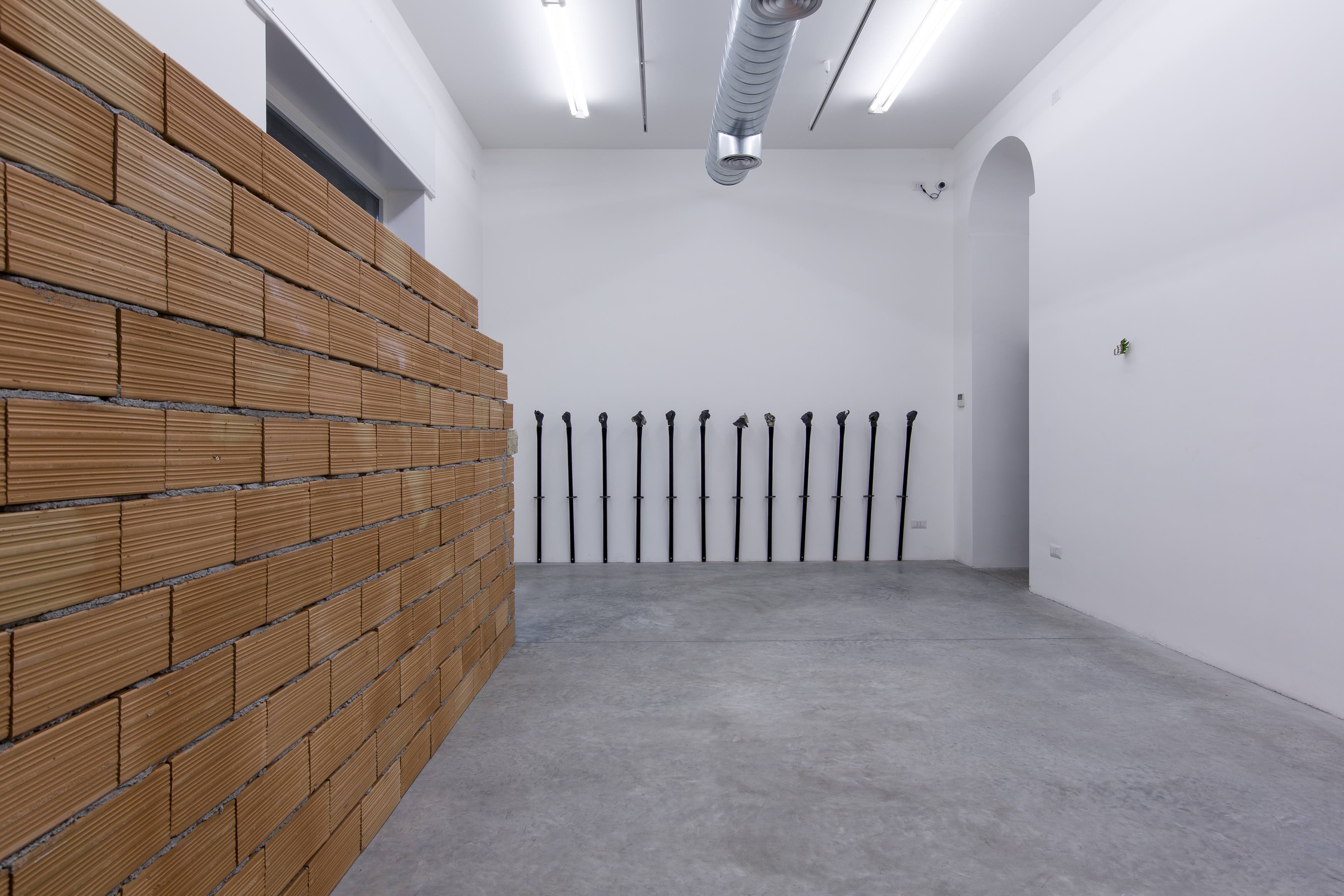
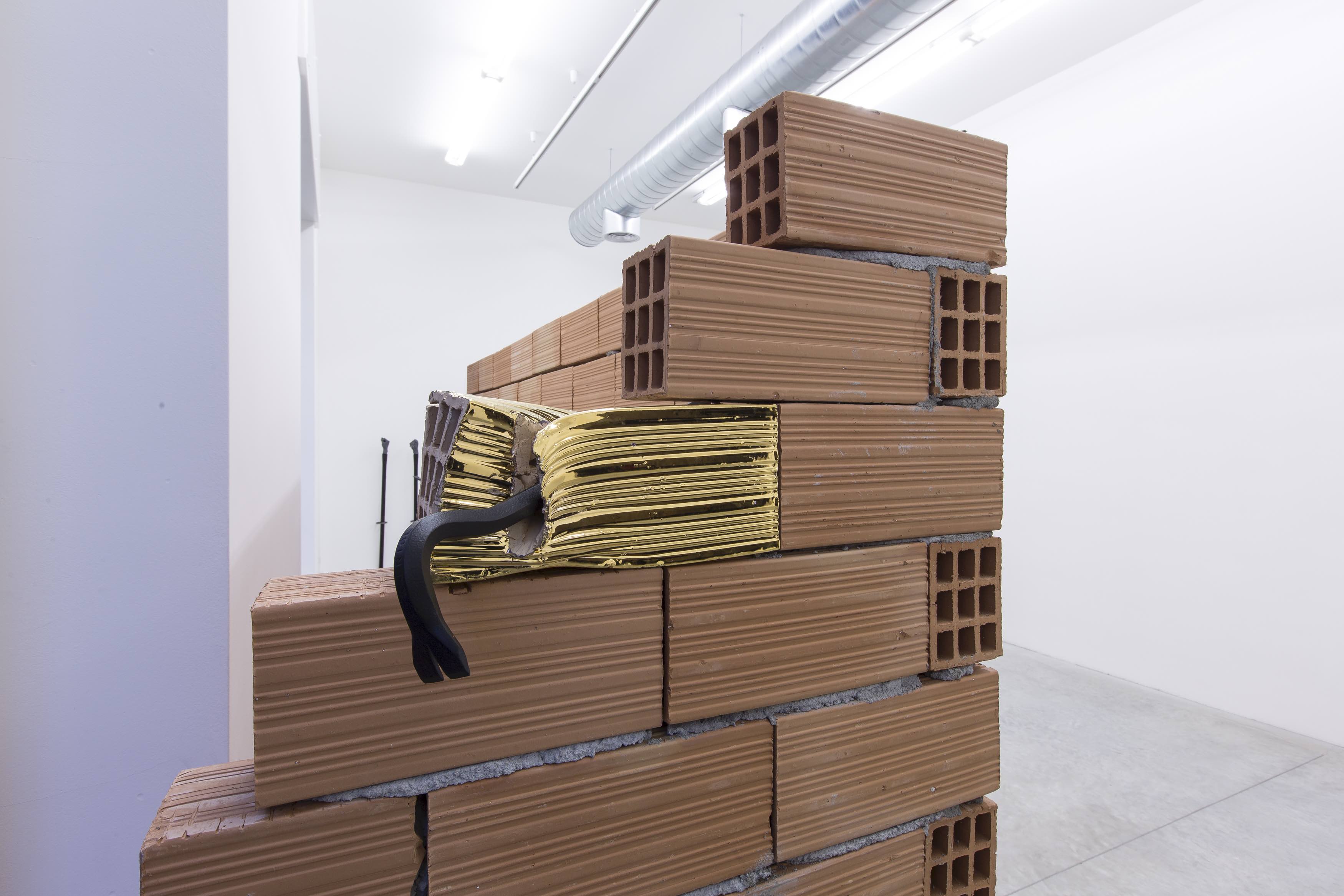
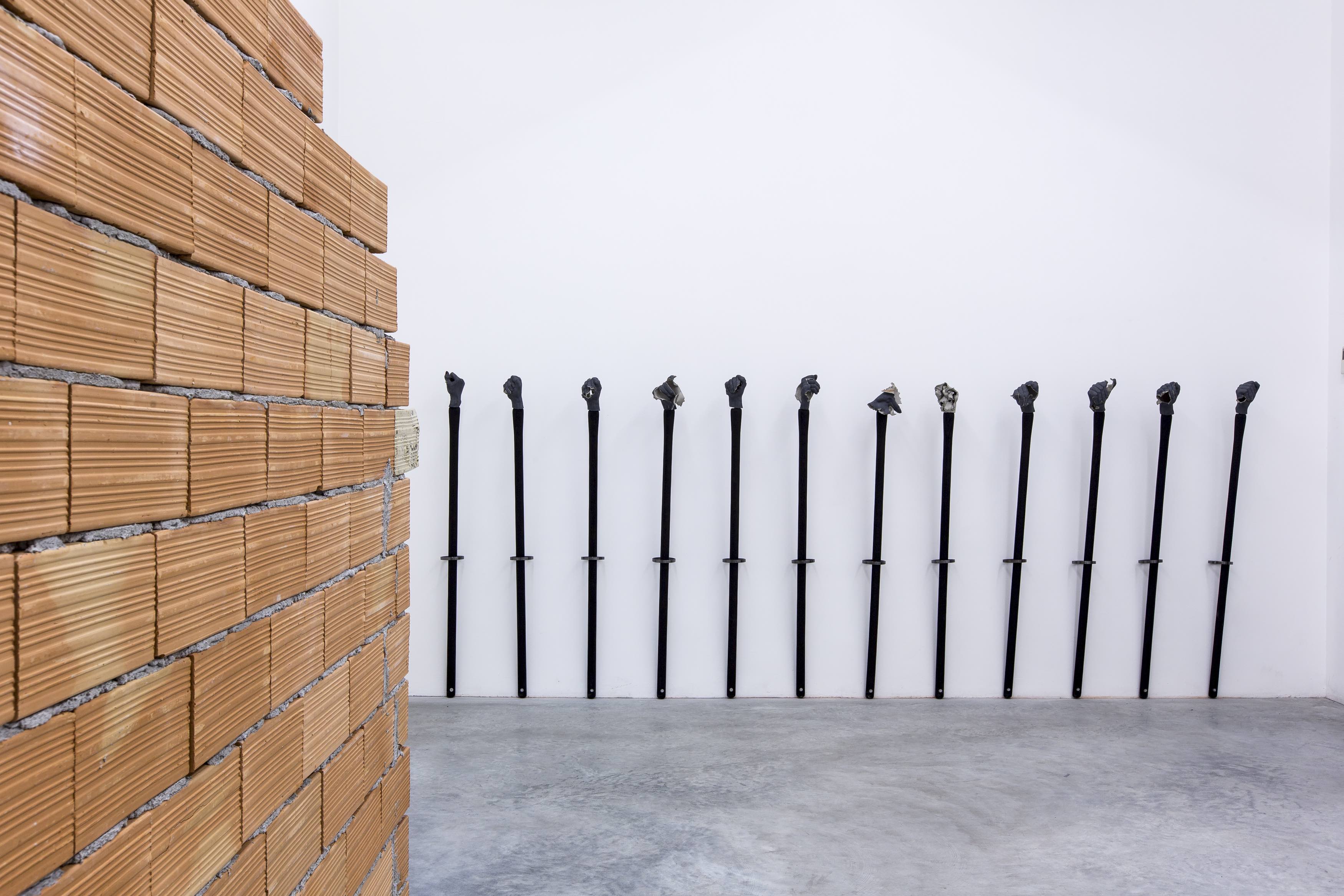
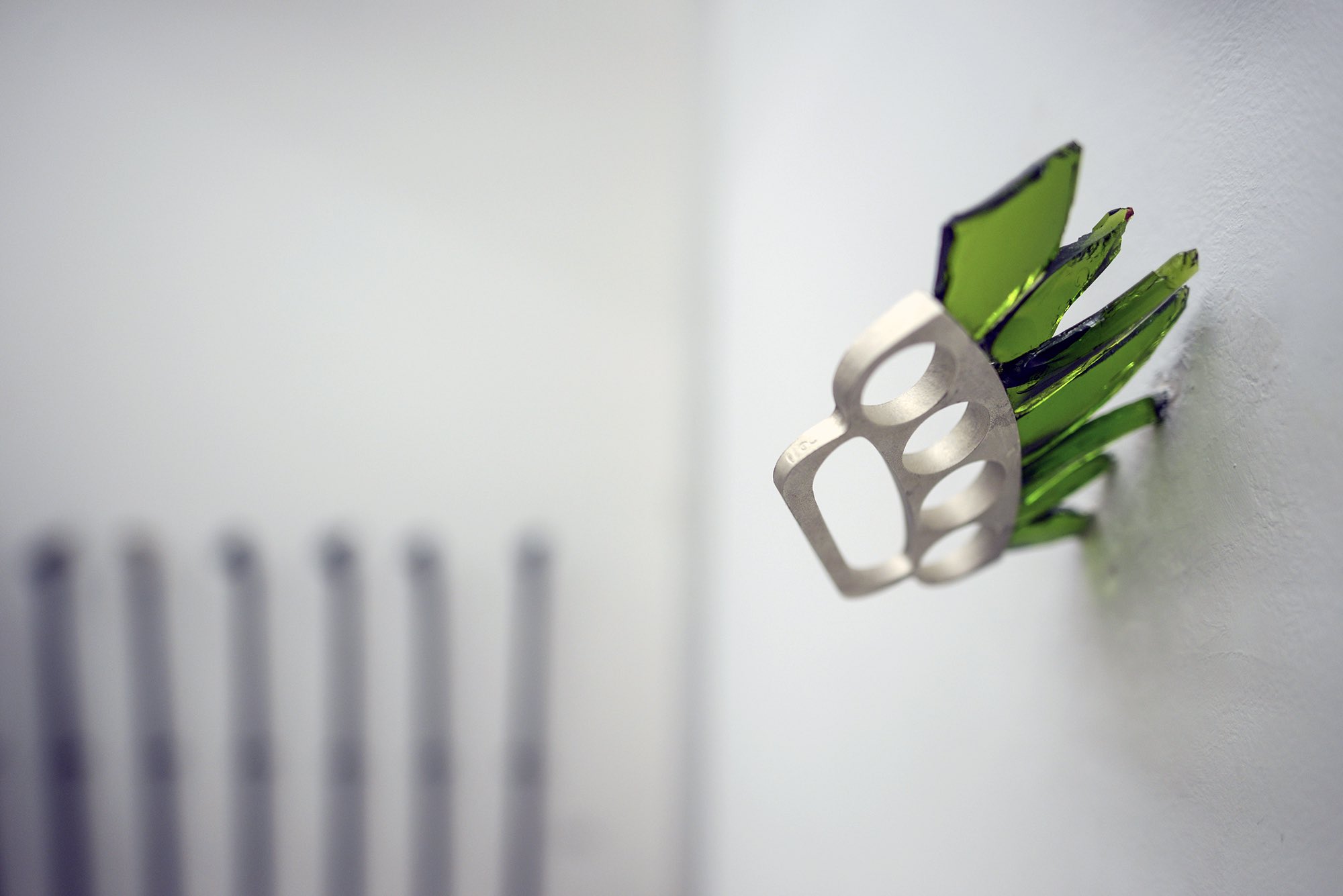
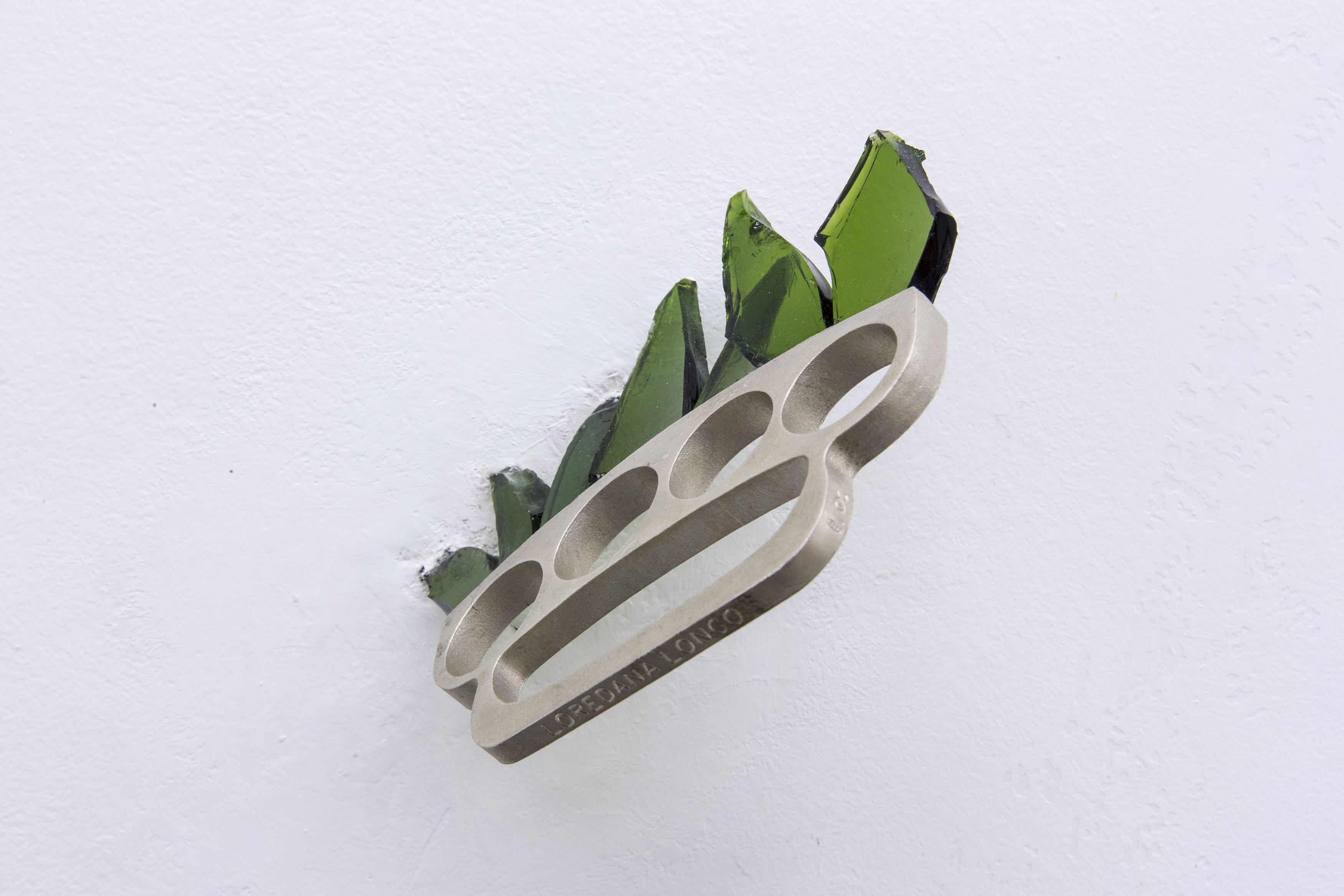
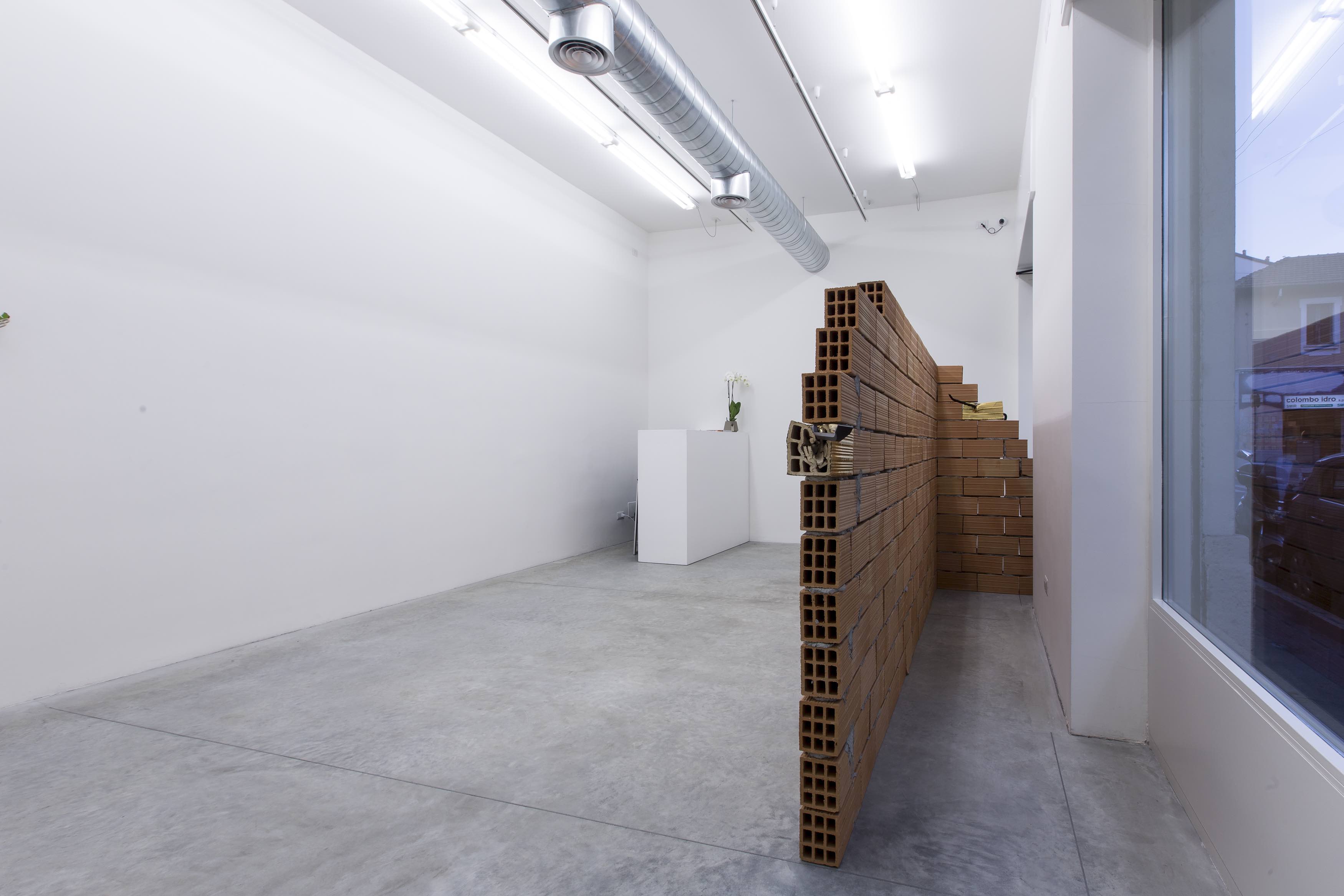
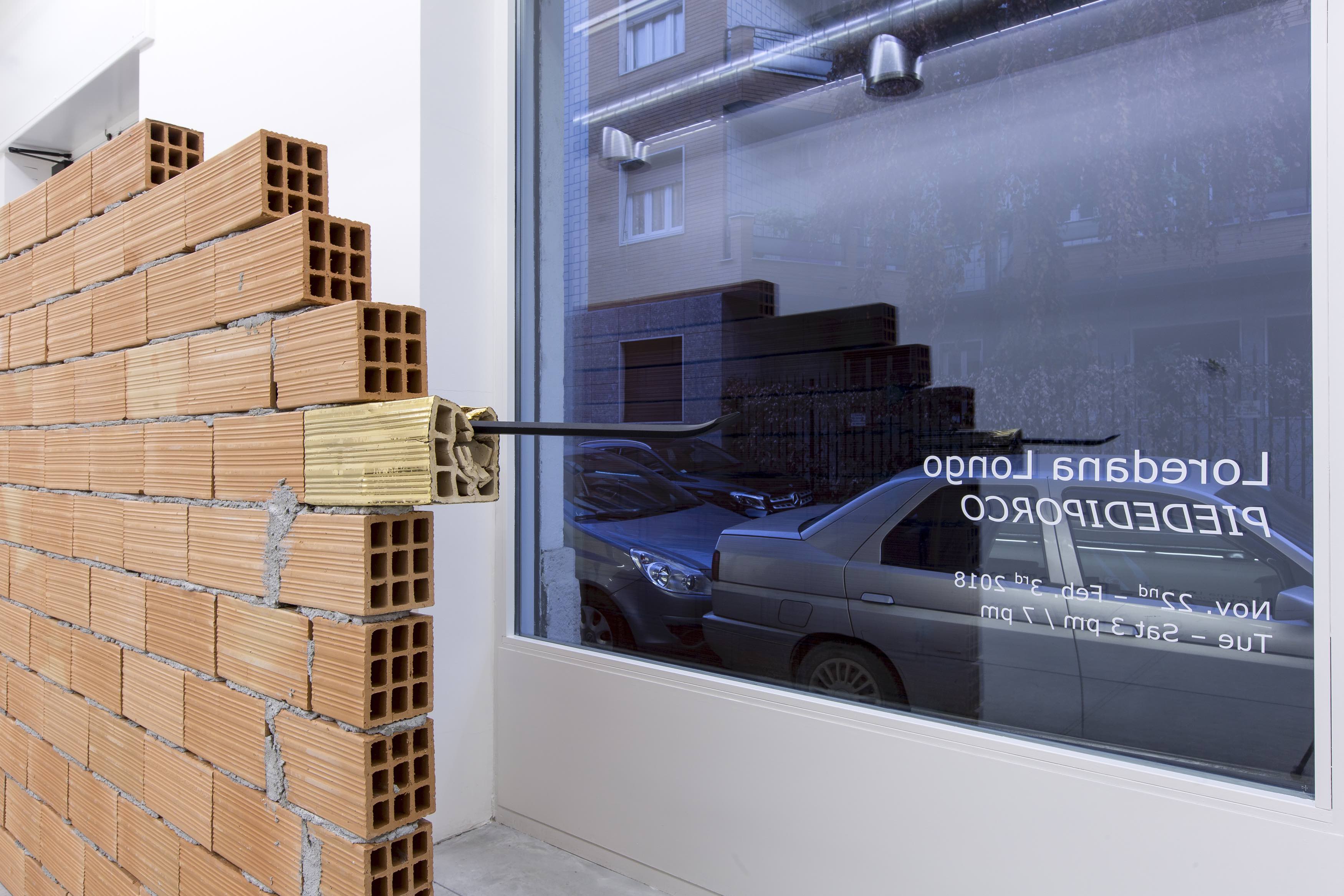
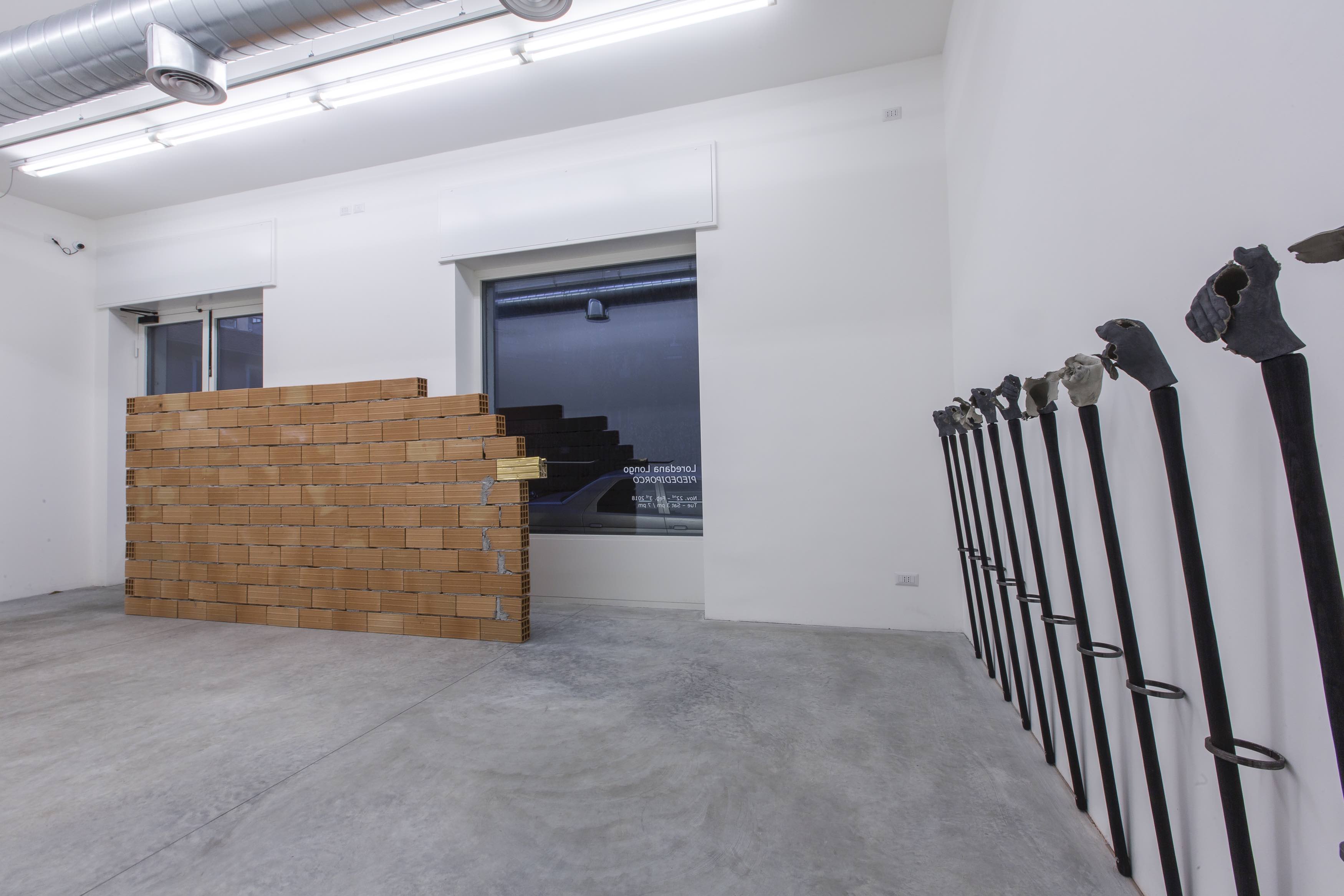
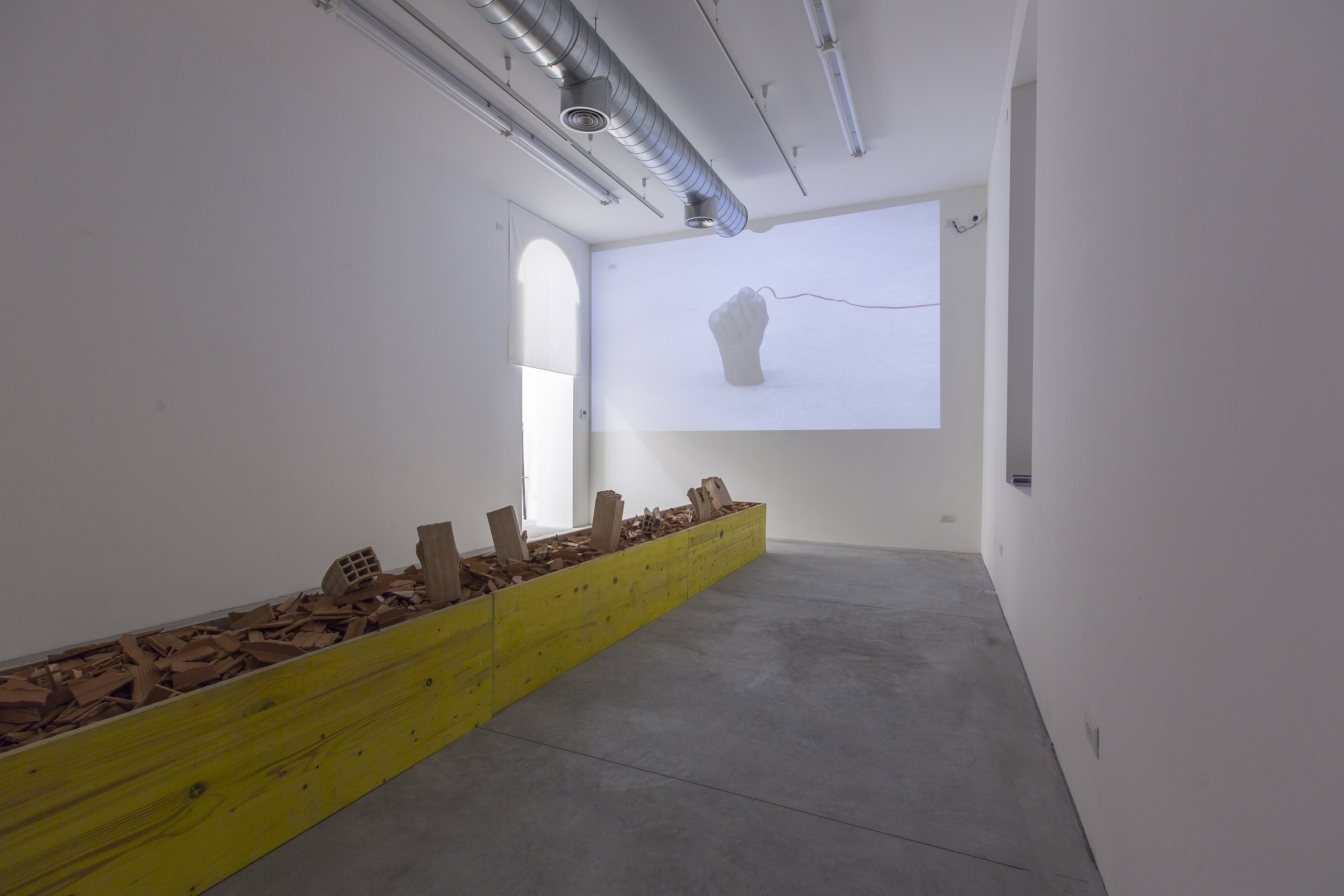

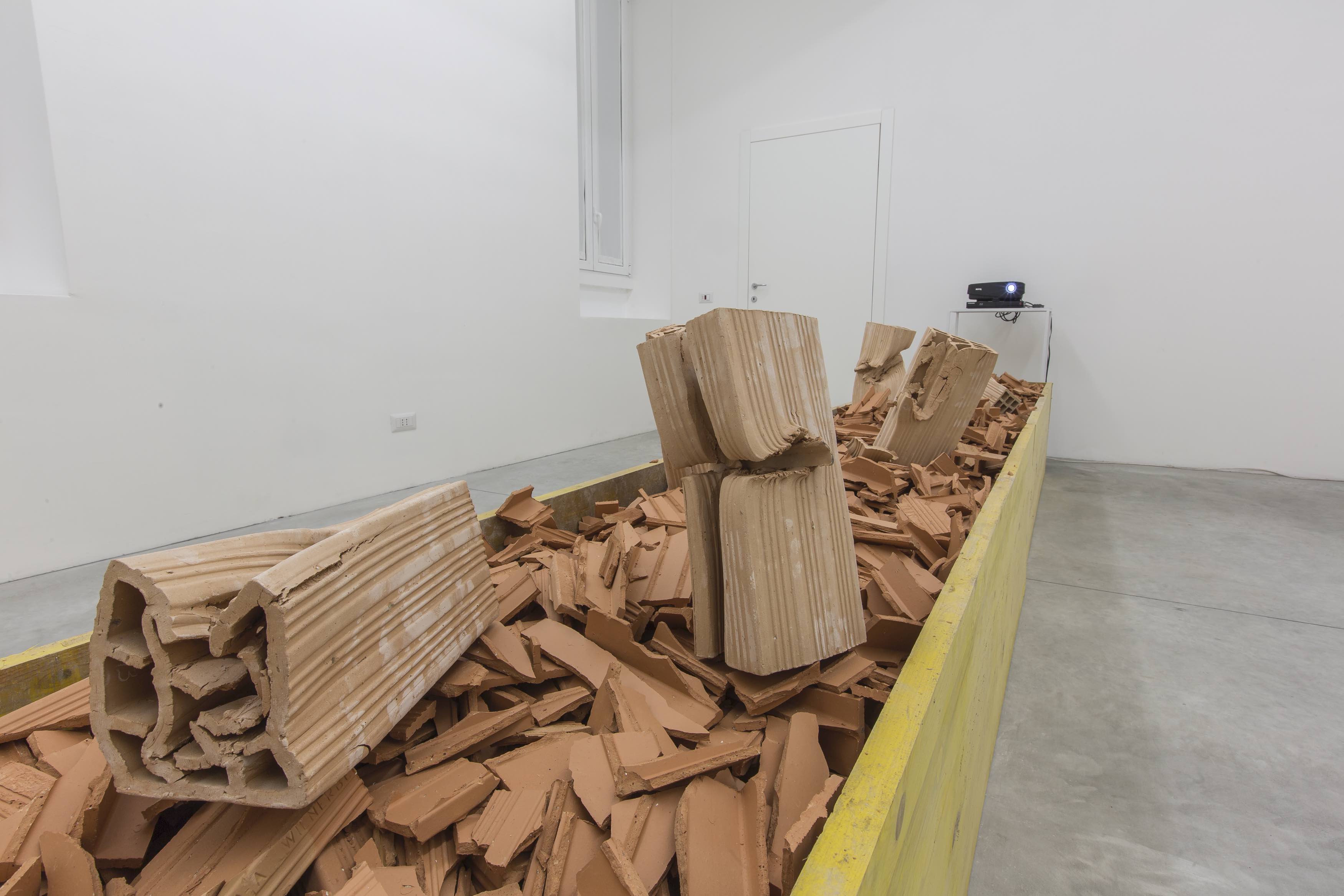
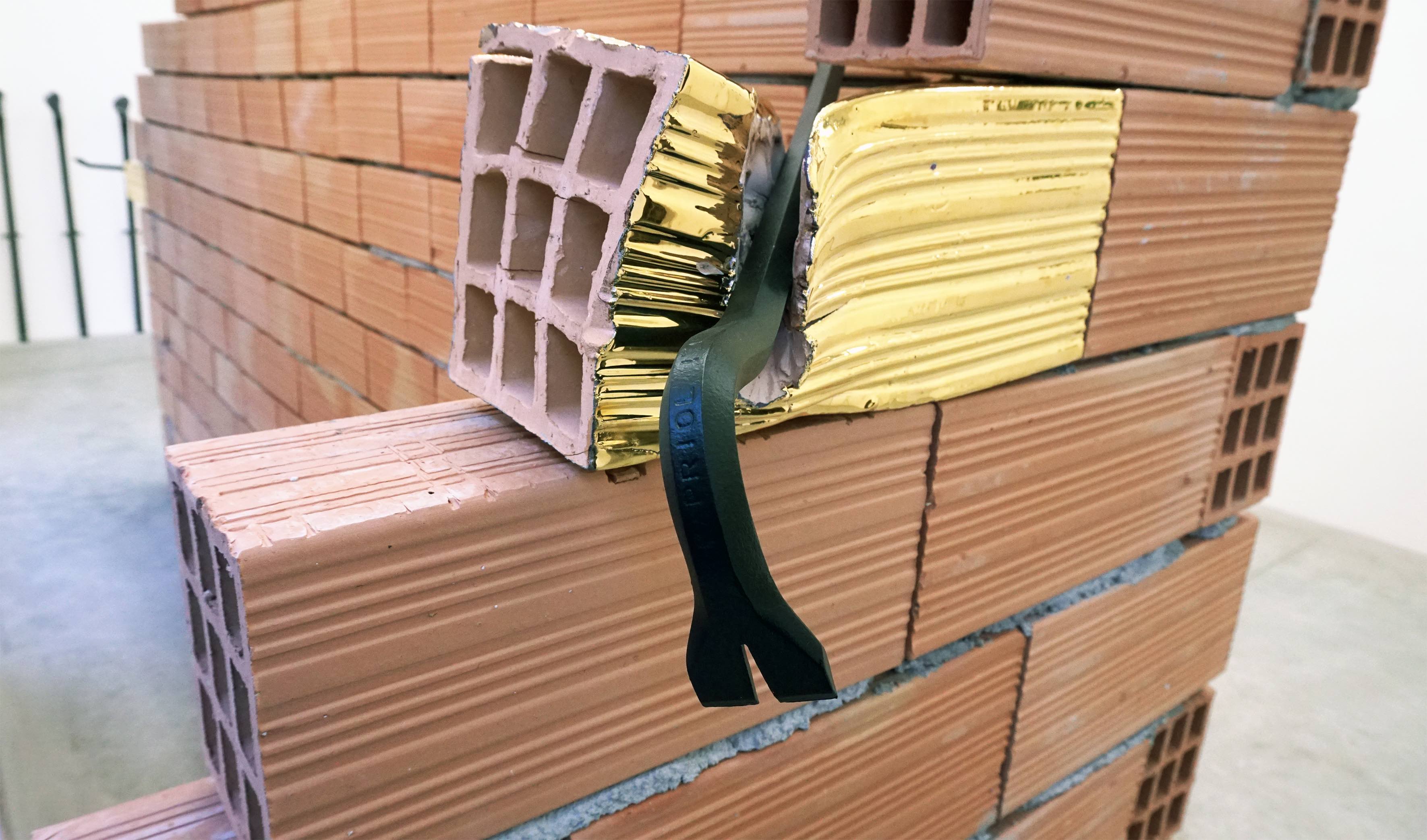
Galleria Francesco Pantaleone Arte Contemporanea, Milano
opere in mostra:
PIEDEDIPORCO, 2017
Muro di mattoni forati, mattone oro, piedediporco, 30x15x12 cm ciascuno
TIRAPUGNI#CHAMPAGNE, 2017
argento, schegge di vetro bottiglia champagne, 10x9x0,6 cm
Courtesy Francesco Pantaleone, Milano
FIST, 2017
12 calchi del pugno dell’artista in ceramica dolce, ossido di ferro, esplosione, smaltate con ossido di rame, legno bruciato, ferro
FIST
Video, durata 3m 24 sec
“La forza purificante della violenza non è alla luce del giorno per gli uomini”
Benjamin, Per la critica della violenza, 1921
Il lavoro di Loredana Longo si fonda, da circa un ventennio, sull’estetica della violenza. Eppure la sua rappresentazione non è mai letterale, né didascalica e attraversa media e linguaggi con una grande libertà. Perfomance, video, installazione, tappeti, arazzi, scultura convivono in una riflessione sulle macerie, sui resti, su ciò che la violenza lascia nelle vite di tutti noi in una rappresentazione che è sempre opulenta (dagli interni dei ricchi salotti borghesi delle explosion ai preziosi tappeti persiani dei carpets) senza tuttavia essere mai barocca.
Nel solco di questa ricerca, in cui convivono ricchezza, pulizia formale e macerie, si inserisce la recente serie piedediporco. I mattoni, dorati a terzo fuoco, convivono con la brutalità del laterizio. La fascinazione di Loredana Longo per la ceramica non passa attraverso una manipolazione del materiale nei suoi elementi arcaici e fangosi, ma per una autentica comprensione delle sue potenzialità plastiche. Nei lavori in mostra è evidente come l’artista abbia deciso di lavorare sulle possibilità della ceramica e in particolare sulla capacità di fissare eternamente la fragilità della materia viscosa. Sia nel caso dei mattoni dorati, che dell’esercito di mani che guarda lo spettatore dalla parete, infatti, l’intervento avviene quando la materia è ancora cruda, carica d’acqua: la violenza che ne trasforma i connotati (sia nelle creste del mattone che nelle mani sfrangiate) è fissata eternamente mediante la cottura. Una violenza che diventa ancora più freudianamente perturbante nel suo essere associata con elementi familiari, quotidiani.
Ed è in questa attenzione per il quotidiano, per l’utensile (le mani sono “infilzate” su bastoni di zappe nel lavoro Fist) che Loredana Longo riesce a tornare all’origine del materiale, al suo primo uso. Sappiamo che l’argilla è infatti nata per creare piccoli oggetti domestici, per contenere cibi, per fare da legante nella costruzione delle case e, successivamente –proprio mediante laterizio- per edificare.
Il muro che sbarra l’ingresso della galleria riparte da quella storia che non è però raccontata senza alcuna nostalgia. Al contrario è proprio mediante il piedediporco, monumentale sulla sommità, che la Storia di violenza civilizzatrice ritorna forte ed evidente.
Vi è in quel mattone dorato tutta la forza della critica ad una società civile, in particolare a quella italiana, fondata ‘sul mattone’. Ed ecco dunque che il piedediporco diventa pietra d’angolo, fondamento di un vivere che è corrotto dalla sua violenza, dalla speculazione.
Nei giorni in cui l’artista realizzava questi pezzi (ed assieme discutevamo su come allestire i detriti che campeggiano nella seconda sala) una comunità terremotata si è recata a Roma per lanciare a terra, davanti alle sedi di governo, le macerie delle proprie case distrutte. Improvvisamente il messaggio di Loredana Longo – in nessun modo connesso a quella vicenda specifica– diventava messaggio politico.
Se la violenza infatti è la via, anche estetica, attraverso cui l’artista costruisce le proprie opere (si pensi all’elegantissimo tirapugni-gioiello in mostra), il messaggio è ineluttabilmente politico. Il mattone, la brutalità della speculazione economica, trova il suo controcanto in nelle ‘zappe’ a parete, primigenia arma del delitto di Caino su Abele. Le mani, che serbano nelle loro lacerazioni la violenza dell’esplosione, rappresentano l’ambivalente coincidenza tra vittima e carnefice. Le loro cromie, un color carne alternato ad un grigio canna di fucile opaco, richiamano la pelle e la polvere esplosiva che le ha fatte saltare. Il suono esteso e dilatato dell’esplosione accoglie lo spettatore ed accompagna i video –montati al rallentatore – che dominano la seconda stanza, dialogando con le macerie.
Polvere da sparo, oggetti contundenti, tirapugni: un armamentario per capire il nostro presente. Così come la rappresentazione dei calcinacci che popolano la seconda sala non è una cronaca, ma una riflessione su di un sentire, allo stesso modo anche le esplosioni delle mani ci ricordano detonazioni di corpi che – tristemente – popolano la nostra quotidianità. La libertà della creazione artistica è la sola risposta, l’unico spazio all’interno del quale poter agire, senza proporre soluzioni, ma permettendo a chi osserva di riflettere su ciò che accade con nuovi occhi. Perché le esplosioni non sono solo quelle dei kamikaze, perché Capaci vive nelle nostre memorie, ma anche nel nostro presente. A tre settimane dalla brutale esplosione dell’auto di una giornalista maltese, donna libera che attraverso le sue attività di inchiesta denunciava la corruzione e speculazione del proprio paese, un’altra donna, libera nella pratica e mai soggetta al medium, ci accompagna in un percorso di violenza. La stessa violenza che, mai definibile, domina la nostra vita in tutti i suoi rapporti.
Galleria Francesco Pantaleone Arte Contemporanea, Milano
artworks exhibited in the show:
TIRAPUGNI#CHAMPAGNE, 2017
silver, shards of glass bottle of barbaresco wine, 10x9x0.6 cm
Courtesy Francesco Pantaleone, Milano
PIEDEDIPORCO, 2017
Perforated bricks wall, gold brick, crowbar
30x15x12 cm each
FIST, 2017
12 casts of the artist's fist in soft ceramic, iron oxide, explosion, glazed with copper oxide, burnt wood, iron
FIST, 2017
Video, time 3m 24 sec
“The expiatory power of violence is not visible to men”
Walter Benjamin, Towards the Critique of Violence, 1921
Loredana Longo’s work has been based, for almost two decades, on the aesthetic of violence. Her representation of it is never lateral, nor pedagogical, but rather through a visual language which she uses with great liberty. Performance, video, installations, carpets, tapestry, sculptures, all coexist to reflect on ruin, remains, on that which violence leaves in all of our lives. The representation is always opulent (from the interiors of rich, Bourgeois salons to the destruction of precious, Persian carpets) without ever being too extravagant.
The crevices of this project, which provide a place for richness, cleanliness, and ruin to coexist, add Crowbar to the collection. The bricks, covered in gold, live with the brutality of industrialized ceramic. Loredana Longo’s fascination with ceramics is not because of it’s archaic and muddy qualities, but because of an authentic understanding of it’s structural potential. The works in this show make evident how the artist chose to work with the possibilities ceramic presents and, more specifically, on the ability to establish the eternal fragility of the material. Both in the case of the golden bricks, and in the army of hands that stare at the viewer from the wall, the intervention occurs when the material is still raw and full of water: the violence transforms the significance (both in the crests of the bricks and in the frayed hands) and is eternally fixed via the firing of the clay. A violence that becomes even more Freudian and perturbing as it is associated with familiar and everyday materials.
This attention to the everyday, to the tools (the hands are pierced onto hoes in Fist), allows Loredana Longo to succeed in returning to the origins of the material, to its original use. We know that ceramic was in fact born to create small, domestic objects, to preserve food, to thicken the structure of a house, and later – precisely through industrial bricks – to build. The wall that bars the entrance to the gallery is based on that origin story, which is told without nostalgia. On the contrary, the crowbar is the means through which the story of civilizing violence returns with force and clarity.
It is in the golden brick that the entire critical force of a civil society, in particular the Italian one, is founded. Thus, the crowbar becomes the corner stone, the foundation of living that is corrupted with violence and gambles. In the exact days in which the artist created these pieces (and when we were discussing together how to install the debris found in the second room), a community of earthquake victims presented themselves in Rome to throw, at the feet of the government, the remains of their very own destroyed houses. Unexpectedly, Loredana Longo’s message – which in no way is connected to that specific case – became a political one.
If violence is in fact the way, even aesthetically, that the artist builds her own works (recalling the elegant, brass-knuckle jewelry on display), the message is inevitably political. The brick, the brutality of economic gambles, finds its counterpart in the hoes on the wall, the primary weapon in the story of Cain and Abel. The hands, which retain in their lacerations the violence of explosion, represent the ambivalent connection between victim and oppressor. Their features, skin-color alternated with an opaque, gunmetal grey, recall skin and the explosive dust that made them blow up. The extended and dilated sound of the explosion greets the spectator and accompanies the videos – in slow motion – which dominate the second room in dialogue with the ruins. Gunpowder, blunt objects, brass-knuckles: tools to understand our present. Similarly, the rubble that populates the second room is not a history, but a reflection of feeling, and in the same way the explosion of the hands reminds us of the explosion of bodies which, sadly, populate our daily lives. The freedom of artistic creativity is the only response, the only internal space to react, without proposing solutions, but permitting the observer to reflect with new eyes. The explosions are not just about the kamikaze, because even the Capaci bombing lives not just in our memory but also in our present-day. Three weeks after the brutal car bombing of a Maltese journalist, a free woman who, through her practice, denounced the corruption of her own country, another woman, free in practice and never subjected to her medium, accompanies us on a violent course. The same violence that, undefinable, dominates our lives in all our relations.